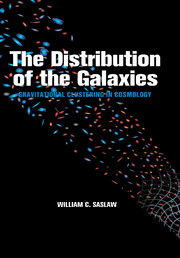Book contents
- Frontmatter
- Contents
- Prologue
- Part I Historical
- Part II Descriptions of Clustering
- 8 Patterns and Illusions
- 9 Percolation
- 10 Minimal Spanning Trees
- 11 Topology
- 12 Fractals
- 13 Bound Clusters
- 14 Correlation Functions
- 15 Distribution Functions
- Part III Gravity and Correlation Functions
- Part IV Gravity and Distribution Functions
- Part V Computer Experiments for Distribution Functions
- Part VI Observations of Distribution Functions
- Part VII Future Unfoldings
- Bibliography
- Index
15 - Distribution Functions
Published online by Cambridge University Press: 19 January 2010
- Frontmatter
- Contents
- Prologue
- Part I Historical
- Part II Descriptions of Clustering
- 8 Patterns and Illusions
- 9 Percolation
- 10 Minimal Spanning Trees
- 11 Topology
- 12 Fractals
- 13 Bound Clusters
- 14 Correlation Functions
- 15 Distribution Functions
- Part III Gravity and Correlation Functions
- Part IV Gravity and Distribution Functions
- Part V Computer Experiments for Distribution Functions
- Part VI Observations of Distribution Functions
- Part VII Future Unfoldings
- Bibliography
- Index
Summary
All is a procession,
The universe is a procession with
measured and beautiful motion.
Walt WhitmanDefinitions
Although galaxy distribution functions were known to Herschel, measured by Hubble, and analyzed statistically by Neyman and Scott, a new chapter in their understanding has opened in recent years. This relates distribution functions to the gravitational clustering of point masses in an expanding Universe. Calculations of the resulting cosmological many-body problem provide new insights into observed galaxy clustering as well as into the results of computer simulations.
Why gravity? When a reporter asked Willie Sutton, a well-known American bank robber, why he robbed banks, he supposedly replied “Because that's where the money is.” As money is the most obvious motivating force of banks, gravity is the most obvious motivating force of galaxy clustering. Unlike the economic parallel, studies of gravitational clustering have the advantage that the rules do not change as the system evolves and is understood better.
Still, the mutual gravitation of galaxies may not be the only significant influence on their clustering. Initial positions and velocities of galaxies when they first form as dynamical entities will help determine their subsequent distribution. This is particularly true on large scales where the distribution has not had time to relax from its initial state. On smaller relaxed scales, the nonlinear interactions of orbits will have dissipated most of the memory of the initial conditions. The nature of this relaxed state will be one of our main themes in subsequent sections and following chapters.
- Type
- Chapter
- Information
- The Distribution of the GalaxiesGravitational Clustering in Cosmology, pp. 141 - 168Publisher: Cambridge University PressPrint publication year: 1999

